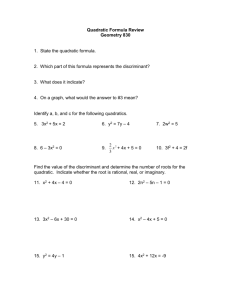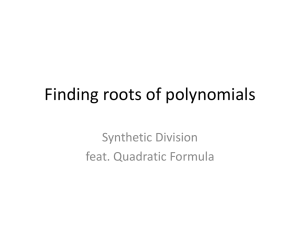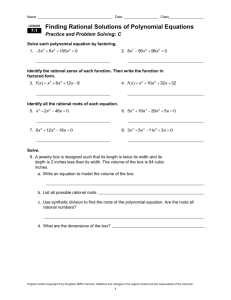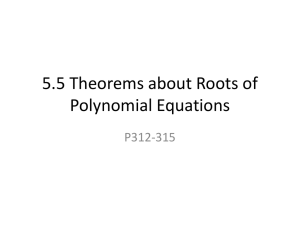Rational Root Theorem and Descarte`s Rule of Signs
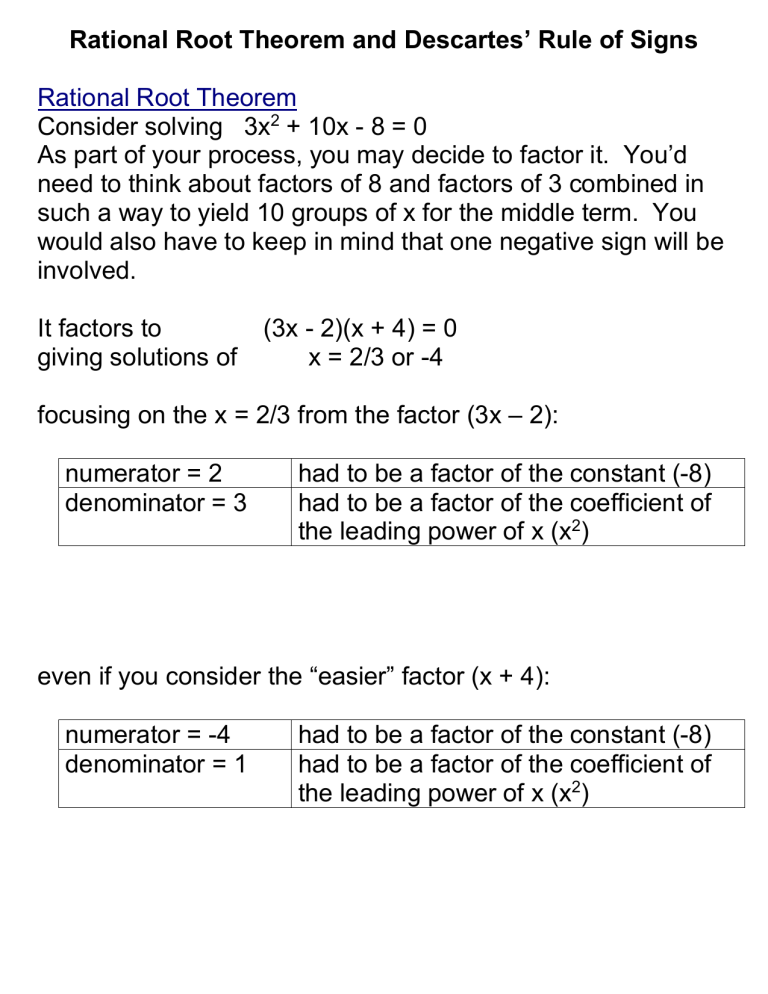
Rational Root Theorem and Descartes’ Rule of Signs
Rational Root Theorem
Consider solving 3x 2 + 10x - 8 = 0
As part of your process, you may decide to factor it. You’d need to think about factors of 8 and factors of 3 combined in such a way to yield 10 groups of x for the middle term. You would also have to keep in mind that one negative sign will be involved.
It factors to (3x - 2)(x + 4) = 0 giving solutions of x = 2/3 or -4 focusing on the x = 2/3 from the factor (3x – 2): numerator = 2 had to be a factor of the constant (-8) denominator = 3 had to be a factor of the coefficient of the leading power of x (x 2 ) even if you consider the “easier” factor (x + 4): numerator = -4 had to be a factor of the constant (-8) denominator = 1 had to be a factor of the coefficient of the leading power of x (x 2 )
The rational root theorem takes this generalization to higher degree polynomials. The possible RATIONAL roots for any polynomial also depend on the factors of the constant at the end of the expression and the coefficient of the highest power of x.
Using the example above, the rational root theorem states that the only possible rational roots are: possible numerators: 1, 2, 4, & 8, (all plus or minus) possible denominators: 1 or 3 possible rational roots:
1
1
,
1
3
,
2
1
,
2
3
,
4
1
,
4
3
,
8
1
,
8
3
We will not ever use this for a quadratic solution, but the same idea applies to polynomials of higher degree.
Descartes’ Rule of Signs
We will use this to narrow down the possibilities when looking for solutions of higher degree polynomials that could have the same 16 choices (or MORE!) for roots as the above quadratic.
I will not repeat Descartes’ Rule here – review the bottom of page 378 in your text.
Part A
First, an “easy” example just using Descartes’ theory:
List the possibilities for the nature of the roots for the following polynomial.
P(x) = x 7 – x 5 + x 4 + 2x 3 + x 2 – x + 1
(work on board)
+ Δ signs: 4
– Δ signs: 3
# roots = 7
# positive real roots (4, 2 or 0)
4
# negative real roots (3 or 1)
3
# imaginary roots
(# remaining to add to 7 – make sure it’s even!!!!)
0
2
0
4
2
3
3
1
1
2
4
2
4
0
Part B
Here is an example tying both ideas together.
Solve 4x 4 + 4x 3 + 17x 2 + 16x + 4 = 0
1. from Descartes:
+ Δ signs: 0
– Δ signs: 4
# roots = 4
# positive real roots (0)
1
# negative real roots (4,2 or 0)
6
# imaginary roots
(#remaining to add to 4 –
0
0
4
2 make sure it’s even!!!!)
0
2
0 0
2. from Rational Root Theorem:
4 possible numerators: 1, 2, 4 (all plus or minus) possible denominators: 1, 2, 4 possible rational roots:
1
1
,
1
2
,
1
4
,
2
1
,
2
2
,
2
4
,
4
,
1
4
2
4
4 after reducing and getting rid of duplicates we have
1
1
,
1
2
,
1
4
,
2
,
1
4
1
Descartes tells us that there are no positive real roots, so we further narrow it to possibilities of
1 ,
1
2
,
1
4
,
2 , and
4
Our first attempt will always be to look for rational, real roots
(and hope that solving the last quadratic will be the only process that gives us imaginary or irrational roots)
Use synthetic division and just start trying . . .
(work on board) methodically trying them, we learn that none work except –
1/2. It is a double root (there had to be an even number of real roots!) Solving the remaining quadratic, we get x = 2i or
–2i. The solution is: x = 2i, -2i, -1/2 (d.r.)



